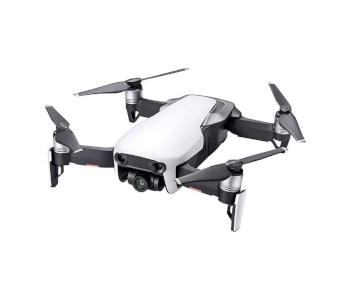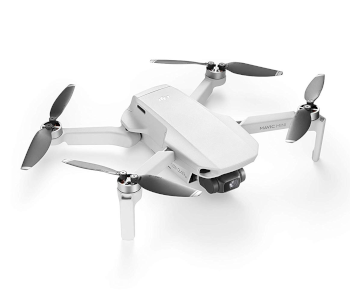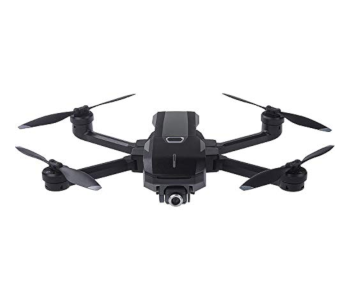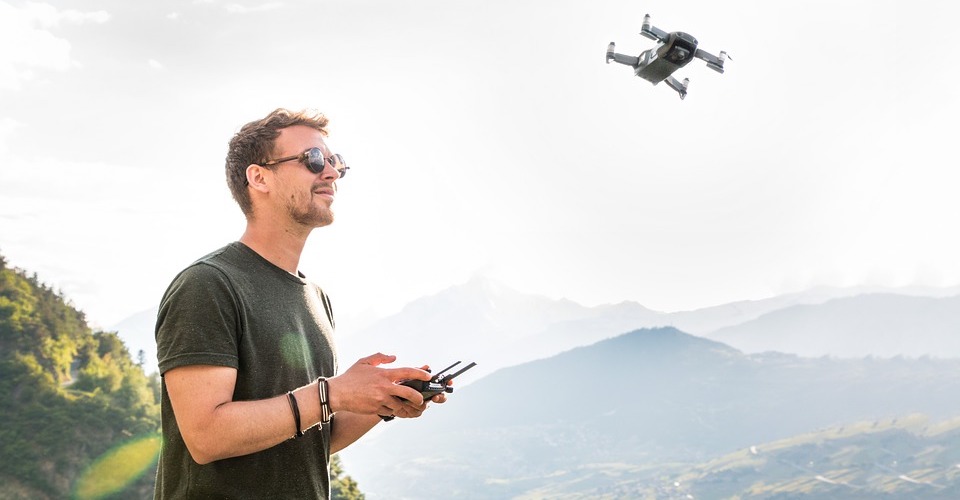DJI Mavic Air and Mini vs. Parrot Anafi vs. Yuneec Mantis Q: Which One Should You Get?
The success of the DJI Mavic Pro back in 2016 paved the way for a whole slew of ultra-portable and lightweight drones from several manufacturers. Nowadays, we can hardly go a few months without another new ultra-portable drone being launched in the market. To make sense of this whole mess, it’s time to ask: which ultra-portable drone should you get in 2019?
For the sake of representation, four of the most successful ultra-portable drones from different brands are going head-to-head in this article. We have the up and coming Mavic Mini and the super popular Mavic Air from DJI, the cinematic Parrot Anafi, and the scrappy Yuneec Mantis Q. Pretty tight competition, right? Let’s check out what each one has to offer.
Overview

The Mavic Air was the third drone to be released in the DJI Mavic line, right after the Mavic Pro and the slightly upgrade Mavic Pro Platinum. Launched in 2016, the Mavic Air proved to be one of the most successful DJI drones to date. For a few years after its release, the Mavic Air remained as the cheapest, smallest, and lightest Mavic drone – which are probably some of the top reasons for why it had become insanely popular.
The Mavic Mini is just fresh off its release, following months of anticipation over a new Mavic drone. Weighing 249 grams, the Mavic Mini just goes under the weight limit that requires drone pilots to register their drones with the FAA. The fact that it’s cheaper, smaller, and lighter than the Mavic Air may be enough to predict how its sales numbers will perform. However, the Mavic Mini had to sustain a few hardware downgrades to achieve such a small form factor.
French company Parrot released the Anafi in July 2018, promising a drone with better specs than the Mavic Air but with a lower price tag. It featured a similar foldable design but looked different enough to stand out in a market that was already getting crowded. It was also the first drone to have a gimbal that allows a 180-degree tilt, making it possible to capture shots from below.
The Mantis Q was released by Yuneec in August 2018 as their answer to the DJI Mavic line. Among its other features, one of the highlighted selling points of the Mantis Q was its voice control function. Indeed, activating your drone by saying, “Wake up Mantis” is pretty darn cool. The Mantis Q also had specs that could stand toe-to-toe with the Mavic Air, but it was much more affordable.
Build, design, and portability
| Parameter | DJI Mavic Mini | Yuneec Mantis Q | Parrot Anafi | DJI Mavic Air |
|---|---|---|---|---|
| Size (folded) | 140 x 82 x 57 mm | 168 x 96 x 57.9 mm | 244 x 67 x 65 mm | 168 x 83 x 49 mm |
| Size (open) | 160 x 202 x 55 mm | 249 x 186 x 57.9 mm | 175 x 240 x 65 mm | 168 x 184 x 64 mm |
| Weight | 249 grams | 476 grams | 320 grams | 403 grams |
The design of the Mavic Air is a classic by now, and simply follows the same design principle as the original Mavic Pro. Its propeller arms fold inward, giving it a very small footprint when folded – smaller than the Mantis Q and the Anafi. Despite the lightweight build of the Mavic Air, it’s a very robust drone that can withstand more than a few scrapes and crashes. This characteristic is something that DJI has been able to maintain throughout the whole Mavic line – these drones can take a beating.
The Parrot Anafi takes a somewhat different approach to portability. Instead of propeller arms that fall inward, the Anafi has arms that fold outward. This gives it a longer and narrower profile when folded up, which actually might be easier to store. We also like how the design of the Anafi isn’t “Mavic-like.” The pronounced placing of the camera right at the nose of the Anafi gives it a distinct look and help it stand out in a sea of Mavic clones. It also helps that the Anafi is slightly lighter than the Mavic Air.
The Mantis Q is the heaviest and the biggest (when unfolded) of the bunch. Instead of having a mostly plastic hull, Yuneec opted to give the Mantis Q a metal enclosure. This is excellent if you’re looking for an ultra-portable drone with a little extra durability. The battery of the Mantis Q also plays a role in its higher-than-usual weight, but we’ll get to that later.
When it comes to weight, the Mavic Mini is in a class of its own. There is no other drone in the market that weighs less than 250 grams that even comes close to the specs of the Mavic Mini. Folded up, the Mavic Mini is almost literally the same size as a smartphone (although obviously a little thicker). The Mavic Mini hasn’t been around long enough for us to comprehensively test its durability, but we’ve seen some drone pilots put it through a beating and have it still fly afterward.
For portability, the Mavic Mini is the clear winner, with both the Anafi and the Mavic Air taking the second spot. Durability-wise, we’ll have to give the metal chassis of the Mantis Q the slight advantage. Both Mavics take the second spot based purely on our experience with Mavic drones.
DJI Mavic Mini: +2 for portability, +1 for durability
Yuneec Mantis Q: +0 for portability, +2 for durability
Parrot Anafi: +1 for portability, +0 for durability
DJI Mavic Air: +1 for portability, +1 for durability
Camera
| Parameter | DJI Mavic Mini | Yuneec Mantis Q | Parrot Anafi | DJI Mavic Air |
|---|---|---|---|---|
| Sensor | 1/2.3” CMOS | 1/3.06” CMOS | 1/2.4” CMOS | 1/2.3” CMOS |
| Video resolution | 2.7K @ 30 fps | 4K @ 30 fps | 4K @ 30 fps | 4K @ 30 fps |
| Image resolution | 12 MP | 12.9 MP | 21 MP | 12 MP |
| ISO Range | 100 – 3200 | 100 – 3200 | 100 – 3200 | 100 – 3200 |
| Shutter speed | 4 to 1/8000 | 1/30 to 1/8000 | 1 to 1/10000 | 8 to 1/8000 |
| Slow motion | 1080p @ 60fps | 1080p @ 60fps | 1080p @ 60 fps | 1080p @ 120 fps |
| RAW/DNG support? | No | Yes | Yes | Yes |
| HDR support? | No | No | Yes | Yes |
The Mavic Mini easily stands out in the camera department, and not for the right reasons. Out of the four drones being compared, it is the only one to not have 4K video recording capabilities. And while a 2.7K video certainly won’t look bad (especially with the Mini’s mechanical stabilization), it feels like a step backward considering how common 4K cameras are nowadays. There’s also the fact that the Mavic Mini cannot capture images in RAW/DNG format and does not have an HDR mode.

Professional photographers will almost certainly find the Mavic Mini lacking, and that seems like one of the consequences of designing a drone this small and light.
The Mantis Q, despite recording in 4K resolution, has a smaller camera sensor. This tends to result in videos that, although technically in 4K, has a clarity more comparable to 1080p. However, the Mantis Q shines in taking still photos. The 12.9 MP photos look great and have good sharpness, further enhanced by the fact that you can save them in RAW format for post-processing.
The performance of the Mantis Q in capturing stills is its saving grace from underwhelming video capabilities. Its video quality would be just on par with the Mavic Mini – it’s simply unusable for any professional cause.
However, the Parrot Anafi trumps all the other drones in still image quality. The 21 MP-equivalent sensor is clearly superior, as is the shutter speed that can go up to 1/10000. Best of all, the Anafi has an auto HDR mode but can also save photos in RAW/DNG format. The 4K video with the 1/2.3” sensor is not bad, either, keeping at par with some of the best ultra-portable drones in this price range. On the strength of the camera alone, the Parrot Anafi is a solid choice for professional drone photographers.
The Mavic Air has an all-around excellent camera that manages to do everything quite well. The 4K video and 12 MP still capabilities are pretty good, although the Anafi edges it out a bit on image resolution. What the Mavic Air has that is missing from all the other drones in this list is a true slow-motion mode – 1080p at a 120-fps framerate.
For drone filmmakers, this feature alone is enough to convince them to go with the Mavic Air. And while its image capture capabilities aren’t as versatile as the Anafi, the Mavic Air also support HDR mode and RAW/DNG capture.
DJI Mavic Mini: +1 for stills, +0 for videos
Yuneec Mantis Q: +1 for stills, +0 for videos
Parrot Anafi: +2 for stills, +1 for videos
DJI Mavic Air: +1 for stills, +2 for videos
Image and video stabilization
| Parameter | DJI Mavic Mini | Yuneec Mantis Q | Parrot Anafi | DJI Mavic Air |
|---|---|---|---|---|
| Technology | 3-axis gimbal | Digital stabilization @1080p | 3-axis gimbal with 180-degree tilt | 3-axis gimbal |
This category is a bit more straightforward. Except for the Mantis Q, all the drones in this list are equipped with a 3-axis gimbal for mechanical stabilization. This is a particularly impressive feat for Mavic Mini because of how small it is, so hats off to DJI for that design choice.
The Parrot Anafi has a slightly different gimbal design, which features a side-mounted camera right at the nose of the drone. This unusual orientation gives the gimbal the freedom to tilt a full 180 degrees, which should allow it to capture images and videos from angles that are impossible for the Mavic Mini or the Mavic Air. For this inventive design alone, we’re giving the Anafi a slight edge.
The lack of a gimbal in the Mantis Q already means that it loses out on this category in a big way. What worsens its situation is that the digital stabilization feature only kicks in at 1080p resolution, making any 4K videos shaky to the point of being unusable. This was such a poor decision on the part of Yuneec and wastes the drone’s 4K capabilities. Even with the digital stabilization activated, the smoothness of the videos captured by the Mantis Q can’t hold a candle to the gimbal-stabilized videos of the other drones.
DJI Mavic Mini: +1 for stabilization
Yuneec Mantis Q: +0 for stabilization
Parrot Anafi: +2 for stabilization
DJI Mavic Air: +1 for stabilization
Controls
| Parameter | DJI Mavic Mini | Yuneec Mantis Q | Parrot Anafi | DJI Mavic Air |
|---|---|---|---|---|
| Comes with controller? | Yes | Yes | Yes | Yes |
| Operating frequency | 2.4 and 5.8 GHz | No data | 2.4 and 5.8 GHz | 2.4 and 5.8 GHz |
| App latency | 170 – 240 ms | No data | No data | 170 – 240 ms |
| Video feed resolution | 720p @ 30 fps | No data | HD 720p | 720p @ 30 fps |
All four drones come with dedicated controllers, and this may very well be the direction of the ultra-portable drone market moving forward. You will still need to use a smartphone with the companion mobile app and hook it up to the controller to view a live feed. No fancy built-in screens here, folks.

The controllers of the Mavic Mini and Mavic Air have a similar design element that takes after the compact build of their respective drones. With antennas that fold in and screw-on analog sticks, these controllers are similarly portable – they can be just as compact the drones are when folded. This was a brilliant stroke on the part of DJI, which maintains the image of the Mavic drones as the drones for an on-the-go lifestyle.
The controller of the Parrot Anafi is a lot bigger and more old-fashioned. It doesn’t boast of folding components, removable joysticks, and a slim profile. Function-wise, it performs similar to those of the Mavic drones, firmly placing it in second place.
The controller that comes with the Yuneec Mantis Q is somewhat compact and portable. It has a larger footprint than the Mavic controllers but has a thin profile and foldable antennas. Our main problem with the Mantis Q controller is that Yuneec seemingly doesn’t provide any technical data on its operating frequency and its video feed quality. This is frustrating in any product.
DJI Mavic Mini: +2 for remote control
Yuneec Mantis Q: +0 for remote control
Parrot Anafi: +1 for remote control
DJI Mavic Air: +2 for remote control
Flight performance
| Parameter | DJI Mavic Mini | Yuneec Mantis Q | Parrot Anafi | DJI Mavic Air |
|---|---|---|---|---|
| Max speed | 13 m/s | 20 m/s | 15.3 m/s | 18.9 m/s |
| Range | 4 km (FCC) | 1.5 km (CE) | 4 km (FCC) | 4 km (FCC) |
| Sensors | GPS + GLONASS | GPS + GLONASS | GPS + GLONASS | GPS + GLONASS |
The Mavic Mini tops out at underwhelming ground speed of only 13 m/s. There’s an argument to be made about flying such a small drone at those speeds, but it’s certainly left in the dust by the much faster Mantis Q and Mavic Air. However, the Mavic Air’s obstacle avoidance will have to be deactivated when entering Sport Mode, where it can fly at maximum speed.
The Parrot Anafi sits somewhere in between. At 15 m/s, the Anafi is slower and less nimble than the Mavic Air. It’s still a pretty fast drone, so no complaints there.
All of the drones are equipped with a dual GPS-GLONASS sensor which aids both flight stability and return-to-home functions. The Mavic Mini, Mavic Air, and Anafi have 4-kilometer transmission ranges. The 1.5-kilometer range of the Mantis Q is based on CE standards, and we can’t say for sure if there’s a corresponding FCC equivalent.
In any case, a 1-mile range is more than enough for drones as small as the ones we’re considering here. Visual flight rules take precedence over the range of transmission technology.
How well each drone responds to the controls and how stable they are while hovering is something that cannot be represented by a metric. Form what we’ve seen, the Mavic Air is an incredibly stable drone despite its size. The Mavic Mini is inherently less stable due to its lightweight frame.
However, drifting is also a problem for both the Anafi and the Mantis Q, despite being a bit on the heavy side. The Mantis Q, in particular, suffers in this category. Even a slight breeze is enough to knock the Mantis Q off its course, making it necessary to have your thumbs trained at the analog sticks at all times.
DJI Mavic Mini: +0 for speed, +1 for stability
Yuneec Mantis Q: +2 for speed, +0 for stability
Parrot Anafi: +1 for speed, +1 for stability
DJI Mavic Air: +2 for speed, +2 for stability
Battery
| Parameter | DJI Mavic Mini | Yuneec Mantis Q | Parrot Anafi | DJI Mavic Air |
|---|---|---|---|---|
| Flight time | 30 minutes | 33 minutes | 25 minutes | 21 minutes |
| Capacity | 2400 mAh | 2800 mAh | 2700 mAh | 2375 mAh |
Remember how the Mantis Q was significantly heavier than the other three drones? Its 2800 mAh is partly to blame for that. However, the 33-minute flight time is certainly worth it and puts it at par with much more expensive drones, such as the DJI Mavic 2 Pro.

Surprisingly, the Mavic Mini comes in second in terms of flight time. By virtue of being an extremely light drone, the Mavic Mini is able to eke out several more minutes of flight from a battery that is about the same size as that of the Mavic Air. For being the gold standard of efficiency, we consider the Mavic Mini as worthy of sharing the top spot with the Mantis Q.
The Parrot Anafi sits right in the middle, both in terms of battery size and flight time. The 25-minutes flight time isn’t mind-blowingly good but is not something we can criticize, either.
On the other hand, the flight time of the Mavic Air certainly hasn’t aged well. At 21 minutes, it has become woefully inferior to most of the other ultra-portable drones that were released since.
DJI Mavic Mini: +2 for flight time
Yuneec Mantis Q: +2 for flight time
Parrot Anafi: +1 for flight time
DJI Mavic Air: +0 for flight time
Obstacle avoidance
| Parameter | DJI Mavic Mini | Yuneec Mantis Q | Parrot Anafi | DJI Mavic Air |
|---|---|---|---|---|
| Obstacle avoidance coverage | None | None | None | Forward, backward, and downward |
Obstacle avoidance is one of the things that separates high-end drones from more budget-oriented ones. It’s not surprising, then, that only the Mavic Air comes with any sort of obstacle avoidance system. It doesn’t end there, though, because the obstacle avoidance system of the Mavic Air is an upgraded version of those found in the older Mavic Pro and Mavic Pro Platinum. If you’re a novice flyer who would like to avoid crashes as much as possible, then the Mavic Air is still your best choice.
The lack of any obstacle avoidance on the other drones is disappointing, albeit expected for their price range. Although these drones are being marketed to the casual market, beginner drone pilots are going to have to watch them like a hawk to keep from crashing.
DJI Mavic Mini: +0 for obstacle avoidance
Yuneec Mantis Q: +0 for obstacle avoidance
Parrot Anafi: +0 for obstacle avoidance
DJI Mavic Air: +1 for obstacle avoidance
Flight modes and camera modes
| Parameter | DJI Mavic Mini | Yuneec Mantis Q | Parrot Anafi | DJI Mavic Air |
|---|---|---|---|---|
| Follow Me | None | None | Yes; locked as in- app purchase | Yes (ActiveTrack) |
| Gesture control | None | Yes | None | Yes |
| Other camera modes | Dronie Rocket Helix Circle | Face detection Journey Point of interest | Dolly Zoom Boomerang Orbit Panorama Hyperlapse | Tapfly Dronie Rocket Circle Helix Asteroid Boomerang |
Autonomous camera modes are some of the more important features in camera drones, especially those geared towards casual users. The Mavic Air certainly takes the cake in this category with its long list of camera modes, the SmartCapture mode which lets you take limited control of the drone using hand gestures, and the optical sensor-aided Follow Me mode called “ActiveTrack.”
The Parrot Anafi has an almost similar list of camera modes, although its lossless zoom capability allows it to the unique “Dolly Zoom” feature. This was the first drone to offer a Dolly Zoom mode and was the only one until the Mavic 2 Zoom was released a few months after.
The Parrot Anafi is the only other drone in this list to offer a Follow Me mode, although you’ll need to pay extra for it via an in-app purchase. Holding back features behind a paywall for a product that users already paid for doesn’t sit well with us, so we’re knocking down the Anafi from the top spot for this reason alone.
DJI Mavic Mini: +0 for camera modes
Yuneec Mantis Q: +0 for camera modes
Parrot Anafi: +1 for camera modes
DJI Mavic Air: +2 for camera modes
Price
| Parameter | DJI Mavic Mini | Yuneec Mantis Q | Parrot Anafi | DJI Mavic Air |
|---|---|---|---|---|
| Approx. price | $399 | $499 | $699 | $919 |
Despite having been in the market for three years, the price of the Mavic Air has not gone down at all. More than anything, this is a testament to how this drone has sustained its popularity, and it may still before its price drops significantly.
The price difference between the Mavic Air and the Anafi is large enough to make the Anafi a very compelling purchase. All other factors set aside, the Anafi is still a fine ultra-portable drone camera that costs more than $200 cheaper.
The Mavic Mini and the Mantis Q can be lumped together in a class that appeals to those who are on a tight budget. The Mavic Mini costs less than half the Mavic Air, and may perhaps be the drone that unseats the Mavic Air from its lofty position.
DJI Mavic Mini: +2 for price
Yuneec Mantis Q: +2 for price
Parrot Anafi: +1 for price
DJI Mavic Air: +0 for price
Verdict
| Parameter | DJI Mavic Mini | Yuneec Mantis Q | Parrot Anafi | DJI Mavic Air |
|---|---|---|---|---|
| Portability | 2 | 0 | 1 | 1 |
| Durability | 1 | 2 | 0 | 1 |
| Image quality | 1 | 1 | 2 | 1 |
| Video quality | 0 | 0 | 1 | 2 |
| Stabilization | 1 | 0 | 2 | 1 |
| Remote control | 2 | 0 | 1 | 2 |
| Speed | 0 | 2 | 1 | 2 |
| Stability | 1 | 0 | 1 | 2 |
| Flight time | 2 | 2 | 1 | 0 |
| Obstacle avoidance | 0 | 0 | 0 | 1 |
| Flight modes | 0 | 0 | 1 | 2 |
| Price | 2 | 2 | 1 | 0 |
| Total | 12 | 9 | 12 | 15 |
Based on the final tally of scores, the Mavic Air comes ahead as the convincing winner. Despite being the most expensive of the bunch, the fact that the Mavic Air is the only one that has an obstacle avoidance system and has the longest list of autonomous camera modes is enough to give it the lead. It also doesn’t hurt that the Mavic Air comes with a 4K camera with HDR mode, better slow-motion capabilities, and a three-axis gimbal. For those looking for a professional-grade ultra-portable drone, the Mavic Air is still a relatively affordable option compared to the DJI Mavic 2 series.
The Mavic Mini and Parrot Anafi come out tied at second. The Parrot Anafi’s camera is arguably better than the Mavic Air’s with its higher image resolution and wider shutter speed options. It’s also around $200 cheaper.
The Mavic Mini may not boast of a camera that can keep up with its contemporaries – it’s downright underwhelming, to be honest – but it’s also the cheapest, smallest, and lightest of the bunch. There is no doubt that the Mavic Mini will have a great mass appeal buoyed by the popular DJI brand.
Aside from its metal frame, good ground speed, and long battery life, the Mantis Q does not offer anything else that puts it at an advantage compared to the other three drones. Unfortunately for the Mantis Q, these are not things that an average buyer would consider when choosing drones – nobody chooses a drone solely because it can stay airborne for a few minutes longer. It’s still pretty cheap, though, and is still a worthy choice if you’re looking for an affordable 4K camera.

